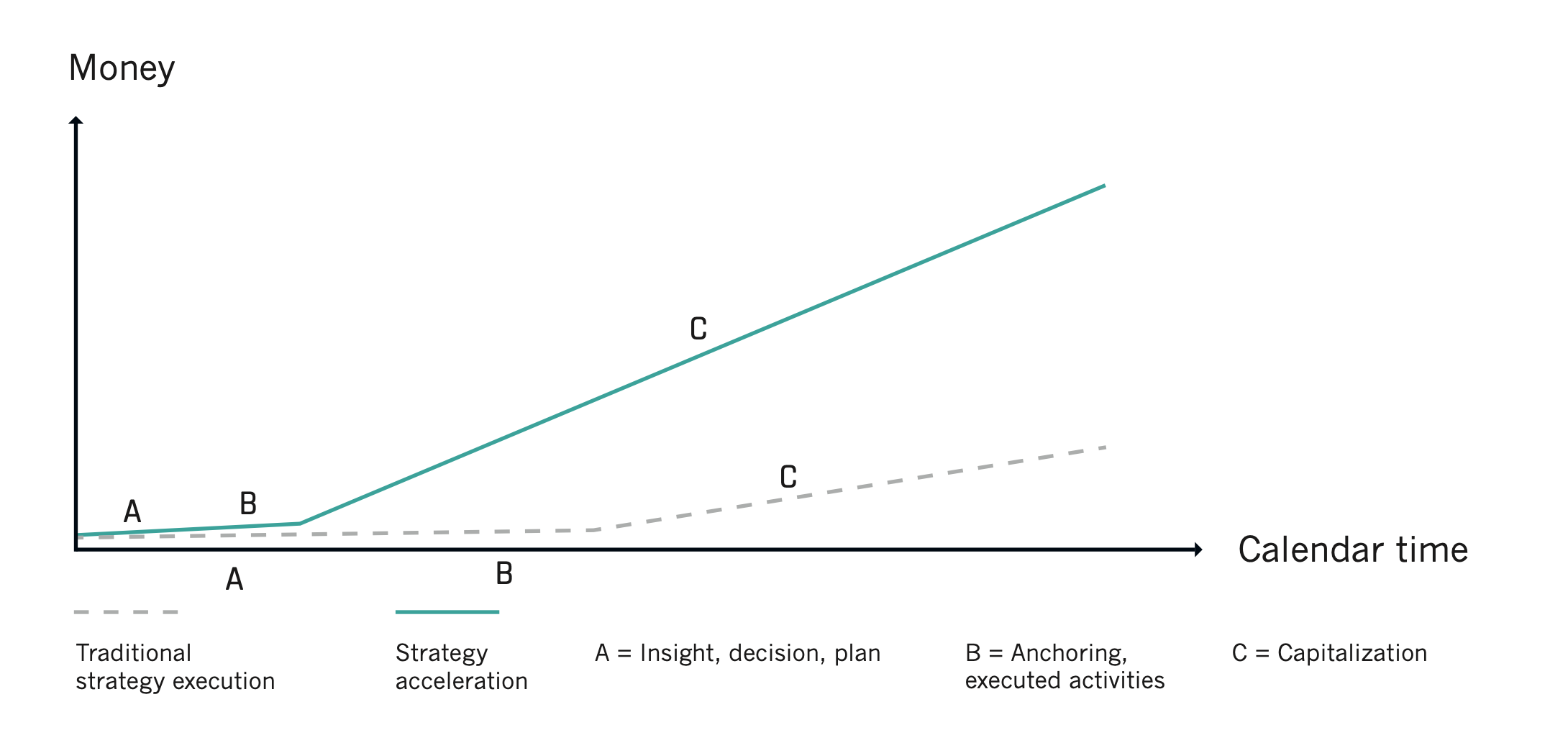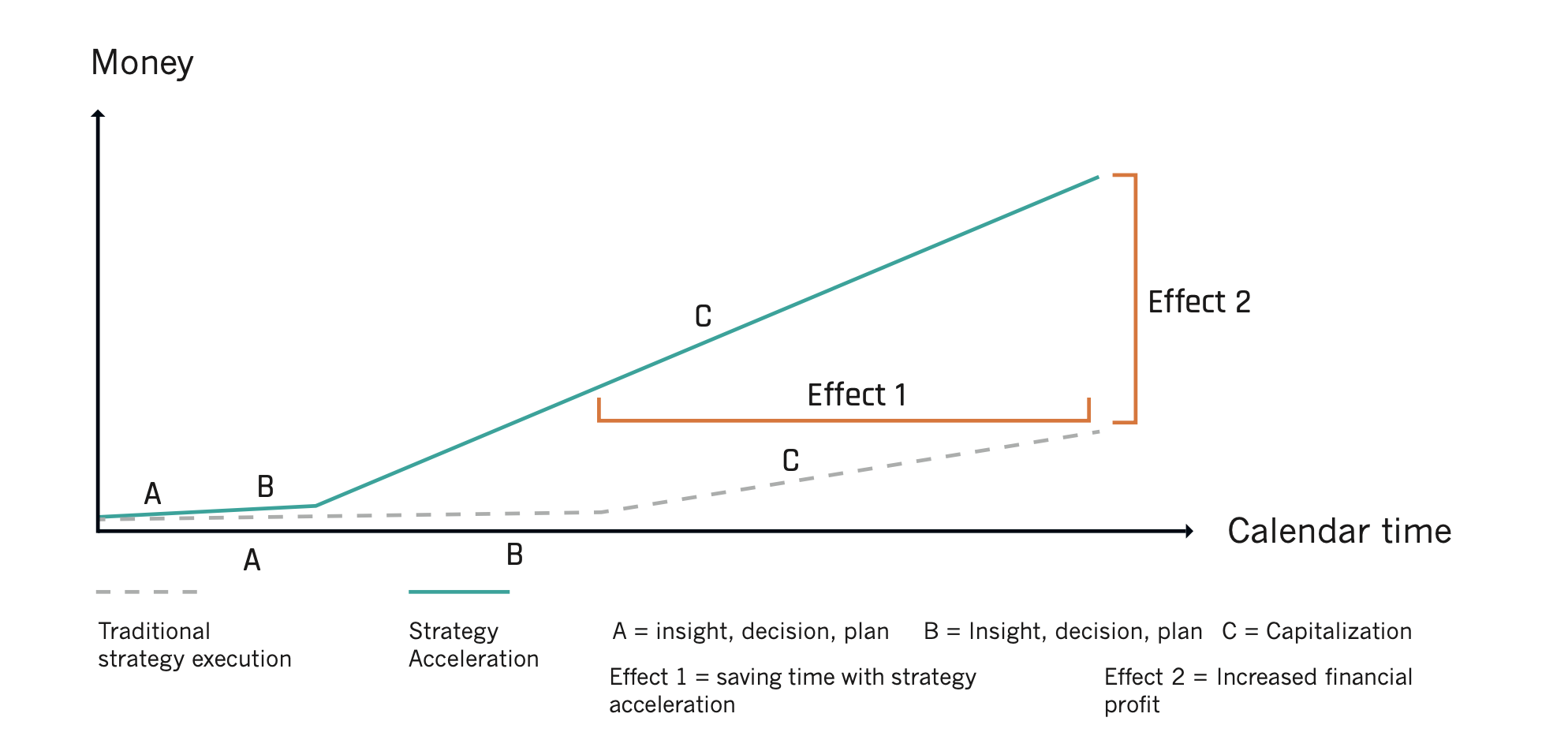Strategy acceleration is all about the company’s future survival and the ability to choose the right way towards success.
This blog post is about money. We will demonstrate how capitalization—i.e. the ability to make money on the strategy execution—is faster with strategy acceleration. You will see that the method is much more profitable than traditional strategy execution. In an easy and practical way, we will explain why this is the case, and how you can think about the financial results of the strategy execution.
To make it easier to explain the financial perspective we would like to show the strategy execution in three different phases: A, B, and C.

Phase A = Going from insight to decision
Phase A is the time it takes to go from insight to decision. In strategy acceleration, the calendar time (i.e. how long it takes to execute the different phases) is considerably shorter than in traditional strategy execution. Since we have a more structured process we will arrive at a decision faster and can make priorities based on money and time.
Phase B = To anchor and accelerate activities
Phase B is about anchoring the strategy in the organization and carry out planned activities. The calendar time in B is, as in the case of phase A, shorter — based on the fact that we only focus on two initiatives (MIGs) and execute the activities according to the structured method that we have described in this blog series.
Phase C = Capitalization
Phase C is when we start making money on the strategy. In strategy acceleration capitalization happens as soon as the activities start showing results. In general, this is a lot quicker than in traditional strategy execution.
After working with strategy execution in a number of companies we have observed that capitalization—the ability to make money on the strategy — consists of two things (effects).
Effect 1 – the gains from executing the strategy faster.
Effect 2 – the improved result is achieved.

Strategy acceleration is about time and money, and this image clearly illustrates this. We are aware that the image above is a simplification of reality but the purpose is to demonstrate the economic aspect of the two different effects using strategy acceleration.
Strategy acceleration — in a nutshell
- Is faster than traditional strategy execution
- Has proven financial gains
- Focuses on few—but most important—goals and activities
- Goals are set based on a financial perspective
- Structured and efficient method where everybody works using the same process
- Continuous anchoring within the organization
- Structured breakdowns of goals that engage EVERYONE who is involved
- Steering and measuring throughout the process
- Continuous (weekly) measuring of both progress and outcome, linked to the actual increase in profit
This leads to:
- Improved ability in handling and adjusting to the changes the company encounters.
- Improved ability to become profitable and successful, both short and long term.
- Increased competitive edge. We do insist that a company that executes strategies faster than others will have a better competitive edge.
Capitalization, but also…
Employees, managers, and management group
We have talked a lot about money in this blog series. How amazing strategy acceleration really is because you can actually increase profit, profitability, and revenue faster and more efficiently. The basis for a company’s survival is the ability to make money, short and long term. Therefore, this aspect is very important and a powerful reason why you should implement strategy acceleration.
BUT… we would like to argue that what truly is the strength of strategy acceleration is that it is a fun and enjoyable way of working. It creates a strong feeling of “We can do anything!” within the company. It becomes a power, a common denominator, and creates a positive atmosphere. It is amazing to witness the strength and energy that flow when everybody strives and works towards a common goal. The happy gleam in the eyes of managers and leaders’ when they see what has been achieved together is unbeatable.
Regardless of whether you are a CEO, part of management, manager, or employee—everyone has something to gain with strategy acceleration.
What’s in it for the employee?
- The employee is involved in the strategy execution in a natural way.
- Participates in the goal setting and in collaboration with the team or the manager also decides what activities should be implemented.
- Clear link between strategy and how my individual work contributes to achieving the company’s goal.
- Experiences a positive atmosphere and sense of community when everybody is striving towards the same goals.
- Experiences that there is an acceptance for spending time on strategic activities and not get stuck in the whirlwind.
What’s in it for the Leaders/Managers?
-
Leaders and managers get a tool to engage all employees in the change that a strategy often entails.
-
Easy to explain how all employees can contribute.
-
A structured method regarding meetings—a follow-up that simplifies and makes work more efficient and fun.
-
A tool to motivate and create a positive atmosphere among the employees.
-
A quicker way to reach economic outcome.
What’s in it for the CEO/Management group?
-
Makes it possible to succeed with the strategy on time, or even before deadline.
-
A way to steer and follow up on the strategy.
-
Can prove acceleration and improved financial results compared to the current position
-
Can steer and measure the strategy execution just as well as the operational work.
-
Feeling secure that the company has a work process in place that enables it to set challenging goals, rather than worrying about rapidly increasing competition and changes in the surrounding environment—and knowing that the organization knows how to be successful
-
Being perceived as modern and innovative
Summary
If you were not already convinced that strategy acceleration is a good method for succeeding with strategy execution, we hope that you are after reading this blog post. All companies that switch to working with strategy acceleration make money from it. How much depends on where they start and what they want to achieve.





